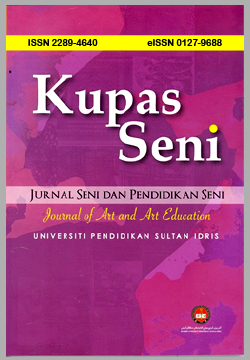Analysing iconography in contemporary socio-political paintings of Malaysian artists' figurative arts
DOI:
https://doi.org/10.37134/kupasseni.vol13.1.2.2025Keywords:
Iconography, Contemporary Painting, Figurative Malaysian ArtistAbstract
The figure images in painting are the core features illustrated by artist to convey specific ideas. The illustrated figure in paintings suggest and reflect artist response in certain issues political and social issues. Thus, this study aims to examine in-depth the in contemporary figurative socio-political paintings by Malaysian artists. The objectives of this research are to explain the process of analyzing iconographic elements related in contemporary figurative paintings and to describe iconographic elements related to socio-political issues in contemporary figurative artworks of Malaysian artist as iconography in addressing socio-political themes in the local visual art landscape. This study involves a qualitative analysis of figurative art by five Malaysian contemporary painters using descriptive analysis with five painting for each phase. The data collection includes images and catalogs of works produced on canvas and paper in various sizes. Subsequently, an in-depth iconographic analysis is conducted by year phase, using the collected images of figurative works as the main subjects to convey socio-political issues in Malaysian artists' contemporary figurative paintings. Based on the theme "iconography in contemporary socio-political figurative art by Malaysian artists," selected figurative paintings will be documented and described. This effort is part of enhancing the documentation process of figurative works by Malaysian painters and emphasizing its significance to society and the development of the Malaysian visual arts scene.
Downloads
References
Ahmad, H., & Yuhanis, R. Iskandar. (2020). An iconographical analysis based on the Erwin Panofsky theory on the Malayness in the paintings of Amron Omar and Haron Mokhtar. Human Resource Management Academic Research Society.
Ahmad Fuad Osman. (2019). From Reformasi to Melaka history: Ahmad Fuad Osman at National Art Gallery [Photograph]. The Star.
Bayu Utomo Radjikin. (2006). [Photograph]. Retrieved from https://padlet.com/yaakobazrin1997/bayuottomoradjikin/wish/252021902
Díaz, R., Carlos, Frías, J. A., Miguélez, G., & Elvira, J. (2023). LiberIC: Iconography and iconology knowledge organization in book representations in painting. Education for Information, 39(1), 67–85. https://doi.org/10.3233/EFI-220016
Erin, B. (2020). Visualizing participatory politics: The communal power of street art in revolutionary Egypt, warring Syria, and divided Lebanon. Senior Thesis.
Fairus, A., & Abdul, H. (2020). Identiti visual seni catan moden Malaysia melalui media campuran dalam konteks kebudayaan. Universiti Pendidikan Sultan Idris.
Fareez, V., & Zahuri, K. (2020). Journal of Applied Arts, 2(1), 146–150.
Hamidi, A. H., Nor Azlin, H., Zahirah, H., & Sabzali, M. K. (2019). Tema dan gaya dalam karya Dalam Sinar Matamu oleh Ponirin Amin. Akademi Pengajian Melayu, Universiti Malaya, 406–438.
Hamir Soib @ Mohamed. (2024). The Collection at UR-MU - Hamir Soib @ Mohamed [Photograph].
Isszarezal, I., & Humin, J. (2020). Seni visual dalam konteks gejala sosial di Malaysia: Interpretasi simbolik pada karya catan Fawwaz Sukri. Fakulti Kemanusiaan, Seni dan Warisan, Universiti Malaysia Sabah. https://doi.org/10.51200/ga.v10i.2582
Isszarezal, I., Hairulnisak, M., Ruzamia, R. A. R., & Muhammad, S. Z. (2022). Visual tubuh manusia dan pesan simboliknya dalam karya seni Bayu Utomo Radjikin. Gendang Alam, 12(1), 1–15. https://doi.org/10.51200/ga.v12i1.3836
Issarezal, I., Ishak, R., Mohd Daud, A. R., Erry, A. A., Hamidi, A. H., & Hamdan, S. (2023). The human soul as a symbolic message in contemporary arts in Malaysia: A study of Daud Rahim’s works. Volume 10(1), 1–10.
Lin, H. (2023). Picture painting ‘Tak Ada Beza’ by Hamir Soib. Gallery Urmu-KL. Retrieved from https://ur-mu.com/gallery
M. Agus, B., Miftakhul, M., & Agatha, C. (2022). The struggle never ends: The reflection on the history of struggle between socio-political groups in the creation of painting. Volume 9(1), 1–11.
Muhammad, H. B., Azmul, F. K., Mohd, F. N. O. Z., Yuhanis, I., Haris, A. A. R., Nik, A. N. H., & Mohd, H. H. (2024). Themes and trends of art collective in Malaysian contemporary art from 2000–2020. International Journal of Academic Research in Business and Social Sciences. Retrieved from http://hdl.handle.net/123456789/6149
Muhammad, H. B., Yuhanis, I., Issarezal, I., Haris, A. A. R., & Nadya, A. K. (2023). The development and significance of art collectives in Malaysian contemporary art. International Journal of Art & Design (IJAD), Universiti Teknologi MARA. https://doi.org/10.24191/ijad
Muliyadi, M. (1992). Seni lukis moden Malaysia. UiTM Shah Alam.
Musnin, M. (2021). Sabah. Journal of Borneo Social Transformation Studies (JOBSTS), 7(1), 1.
Othman, L. (2017). Penyelidikan kualitatif: Pengenalan kepada teori dan metod.
Ramin, H., & Muhamad, F. R. (2023). The reflection of peace and violence in visual art works of Malaysian artists. Peace Review, 336–346. https://doi.org/10.1080/10402659.2023.2188115
Rosliza, Z., Verly, V., Mumtaz, M., & Rafeah, L. (2021). Iconography underpinning Malaysian portrait painting. AMERABRA e-CeBs.
Samsuddin Lappo. (2016). [Photograph]. Retrieved from suddin.lappo.blog.com
Syed, A. B., Syed A. S. A. B., & Rosmidahanim, R. (2023). Adaptasi metafora dalam menyampaikan makna melalui kajian visual bagi karya seni kontemporari terpilih oleh Jalaini Abu Hassan siri pameran ‘Re-Found Object’. KUPAS SENI, 11(3), 8–21. https://doi.org/10.37134/kupasseni.vol11.3.2.2023
The Artling. (2013). Jalaini Abu Hassan - Profile & Content. [Photograph]. Retrieved from https://theartling.com
Zakaria, A. (2019). Seni figuratif & isu sosial: Perspektif alam Melayu olahan isu semasa oleh Ahmad Fuad Osman, Gan Chin Lee, Bayu Utomo Radjikin dan Marvin Chan. Wacana Institut Alam dan Tamadun Melayu, Universiti Kebangsaan Malaysia Bangi.
Zdravka, V. (2019). From figurative painting to painting of substance – The concept of an artist. Studies in Arts, 2(2), 35–44. https://doi.org/10.32591/coas.ojsa.0202.01035v
Downloads
Published
How to Cite
Issue
Section
License
Copyright (c) 2025 Zarina Abdullah, Mohd Zahuri Khairani

This work is licensed under a Creative Commons Attribution-NonCommercial-ShareAlike 4.0 International License.





